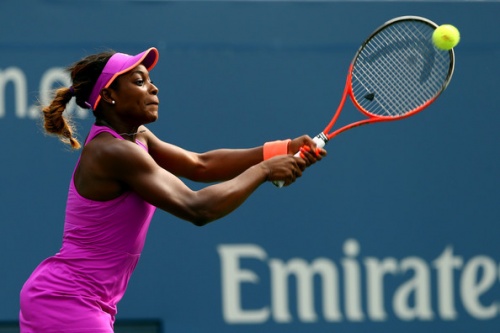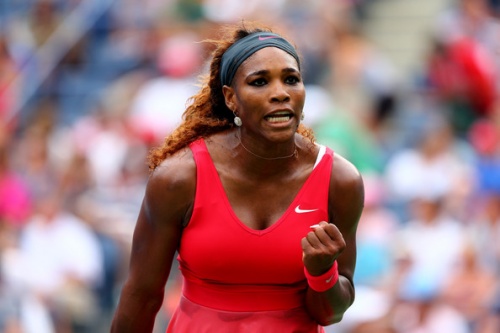Don't miss any stories → Follow Tennis View
FollowThe Future Is Not Now: Serena Williams Dismisses Sloane Stephens
The present and the future of American women’s tennis strode onto the grandest stage in American tennis today. World No. 1 Serena Williams and Australian Open semifinalist Sloane Stephens entered Arthur Ashe Stadium as two of the only three women to reach the second week at every major this year. (The crafty Agnieszka Radwanska is the third.) While Serena and Sloane never had squared off before this year, their history already has been memorable.

At the Australian Open, the younger American burst onto the international tennis scene at the expense of her veteran compatriot. Trailing by a set and a break, Stephens clawed back into that match as a visibly injured Serena faded. Nothing whets the 16-time major champion’s appetite more than the prospect of revenge for such a public blot on her reputation, and Stephens merely added fuel to the flame with controversial comments about Serena’s character to the media.
But the stakes rose higher for Serena in this match than they might have appeared at first glance. While she had annihilated the field en route to her second Roland Garros title, she had lost by the quarterfinals at the other two majors. Dominant at non-majors and vulnerable at majors in 2013, Serena needed a strong performance in New York to finish the season as the undisputed queen of tennis. And she has found unheralded threats more dangerous than elite rivals at majors over the last few years, so she needed to stay on her guard against Stephens.
Fortunately for Serena, the revenge motive seemed likely to sharpen her focus. She had reached the second week in imperious fashion, but Stephens also had scored overwhelming victories in her previous two matches after dodging a near-upset in the first round. High expectations surrounded this match because of the history between the two women, their strong recent form, and the contrast in their playing styles.
That contrast between Serena’s offense and Sloane’s counterpunching would shape the match. The youngster would aim to force the veteran to hit extra shots to finish points, while the veteran would aim to take command with unanswerable first strikes. Serena delivered an ominous message immediately with an ace that opened a love hold. Not intimidated, Stephens responded with penetrating groundstrokes designed to rob the world No. 1 of time to set her feet and unload on her weapons.
Those trends seemed likely to define a match in which the youngster’s chances would improve with every additional stroke that the rallies extended. On only two points in Serena’s first two service games did Stephens even put the return in play, while she struggled to corral her own first serve. Two careless errors from Sloane opened the door in the fourth game. Three break points were earned and then saved with fierce groundstrokes from both sides, the underdog finding clutch first serves and forehands when she needed them most.
Stephens cracked a 102-mph winner and a 119-mph serve en route to holding, but she had faced much more pressure on serve than her opponent had so far. That pressure told in the sixth game, a quick break for Serena after some overhitting by the youngster. In an uncharacteristic lapse, Serena then yielded consecutive double faults from 4-2, 30-30 to thrust the set back on serve.
A sequence of confident forehands swiped away another break point on the Stephens serve in the next game as she stepped inside the baseline and smartly wrong-footed Serena. She had faced break point or deuce in every service game, yet somehow she remained on level terms in the first set. Meanwhile, normal service had resumed on the Williams serve with another easy hold that forced Stephens to hold to stay in the set.
Fusing stunning shot-making with alert defense, Serena quickly moved within two points of a set-ending break. When her cross-court backhand forced Stephens out of position, she earned her first set point. Then it came time for Stephens to unleash a deep cross-court backhand of her own as she survived the tense game. Another set point came and went before the third time proved the charm. Unable to make a comfortable forehand putaway that would have carried her to 5-5, Stephens donated two unforced errors on the last two points of the set.
But both women knew that the match was far from over. After all, Serena had led by a set at the Australian Open before Stephens had rallied, and she also had lost after winning the first set in her last tournament, Cincinnati. Sure enough, a break point knocked on the door in the first game of the second set as Stephens continued to stay positive. The longest game on her serve by far nevertheless ended with a hold, not permitting the underdog the breathing room that she would have wanted.
Stephens answered the challenge with her strongest service game of the match, winning a key point with a cross-court forehand that barely grazed the sideline. That game proved an anomaly as Serena’s defense and movement combined with a clean winner off her return to earn a break for 3-1.
From there, the route to the quarterfinals grew smoother for Serena. A disheartened Stephens won only one point over the next two games as she dropped eight of the last nine games overall.

Restoring her command over the hierarchy of American women’s tennis, Serena ended the match more dominant than she started it. Her far more emphatic serve proved the decisive factor in lightening the pressure during a match where her nerves surfaced at times. Outside that lapse midway through the first set, she pinned Stephens on the defensive relentlessly and never gave her a chance to seize the initiative. The world No. 1 next will meet Carla Suarez Navarro in the quarterfinals on Tuesday after that Spaniard upset top-eight seed and former US Open semifinalist Angelique Kerber.
While she fell short in the rematch of Melbourne, Stephens should feel satisfied with her tournament overall. She reached the second week of the US Open for the first time and severely tested Serena for long stretches of the first set. Her serve must grow more reliable to hang with a server as imposing as her opponent today, but one could say the same about many of the WTA’s most talented players. The future is not now, but it is not far away either.










